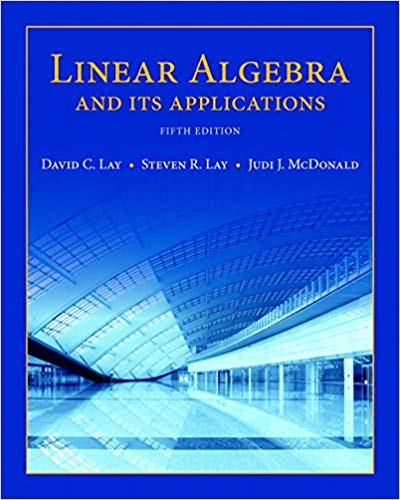
Linear Algebra and Its Applications, 5th Edition
Authors: David C. Lay, Steven R. Lay, Judi J. McDonald
ISBN-13: 978-0321982384
We have solutions for your book!
See our solution for Question 11E from Chapter 1.2 from Lay's Linear Algebra and Its Applications, 5th Edition.
Problem 11E
Chapter:
Problem:
Find the general solutions of the systems whose augmented matrices are given in Exercises...
Step-by-Step Solution
Step 1
Given Augmented Matrix:
\[\left[ {\begin{array}{*{20}{c}}3&{ - 4}&2&0\\{ - 9}&{12}&{ - 6}&0\\{ - 6}&8&{ - 4}&0\end{array}} \right]\]We have to find the general solution of the system of equations of above augmented matrix. By suitable row operations, we will convert the matrix into row reduced echelon form.
Step 2: ${R_2} = {R_2} +3{R_1} $ and ${R_3} = {R_3} +2{R_1} $
\[\begin{array}{l}A = \left[ {\begin{array}{*{20}{c}}3&{ - 4}&2&0\\{ - 9}&{12}&{ - 6}&0\\{ - 6}&8&{ - 4}&0\end{array}} \right]\\\\ = \left[ {\begin{array}{*{20}{c}}3&{ - 4}&2&0\\{ - 9 + 3\left( 3 \right)}&{12 + 3\left( { - 4} \right)}&{ - 6 + 3\left( 2 \right)}&{0 + 3\left( 0 \right)}\\{ - 6 + 2\left( 3 \right)}&{8 + 2\left( { - 4} \right)}&{ - 4 + 2\left( 2 \right)}&{0 + 2\left( 0 \right)}\end{array}} \right]\\\\ = \left[ {\begin{array}{*{20}{c}}3&{ - 4}&2&0\\0&0&0&0\\0&0&0&0\end{array}} \right]\end{array}\]
Step 3: Divide first row by 3
To obtain pivot element as 1, in first row
\[\begin{array}{l}A = \left[ {\begin{array}{*{20}{c}}3&{ - 4}&2&0\\0&0&0&0\\0&0&0&0\end{array}} \right]\\\\ = \left[ {\begin{array}{*{20}{c}}{3/3}&{ - 4/3}&{2/3}&{0/3}\\0&0&0&0\\0&0&0&0\end{array}} \right]\\\\ = \left[ {\begin{array}{*{20}{c}}1&{ - 4/3}&{2/3}&0\\0&0&0&0\\0&0&0&0\end{array}} \right]\end{array}\]
Step 4: The system of Equations
\[\left\{ \begin{array}{l}{x_1} - \frac{4}{3}{x_2} + \frac{2}{3}{x_3} = 0\\0{x_1} + 0{x_2} + 0{x_3} = 0\\0{x_1} + 0{x_2} + 0{x_3} = 0\end{array} \right.\]
Step 5: General Solution
In the above equations, the variables $x_2$ and $x_3$ can be considered as free variables, and $x_1$ can be written in terms of free variables. So, General Solution is \[{\rm{SOLUTION}}:\left\{ \begin{array}{l}{x_1} = \frac{4}{3}{x_2} - \frac{2}{3}{x_3}\\{x_2}\,\,{\rm{free}}\\{x_3}\,\,{\rm{free}}\end{array} \right.\]
Given Augmented Matrix:
\[\left[ {\begin{array}{*{20}{c}}3&{ - 4}&2&0\\{ - 9}&{12}&{ - 6}&0\\{ - 6}&8&{ - 4}&0\end{array}} \right]\]We have to find the general solution of the system of equations of above augmented matrix. By suitable row operations, we will convert the matrix into row reduced echelon form.
Step 2: ${R_2} = {R_2} +3{R_1} $ and ${R_3} = {R_3} +2{R_1} $
\[\begin{array}{l}A = \left[ {\begin{array}{*{20}{c}}3&{ - 4}&2&0\\{ - 9}&{12}&{ - 6}&0\\{ - 6}&8&{ - 4}&0\end{array}} \right]\\\\ = \left[ {\begin{array}{*{20}{c}}3&{ - 4}&2&0\\{ - 9 + 3\left( 3 \right)}&{12 + 3\left( { - 4} \right)}&{ - 6 + 3\left( 2 \right)}&{0 + 3\left( 0 \right)}\\{ - 6 + 2\left( 3 \right)}&{8 + 2\left( { - 4} \right)}&{ - 4 + 2\left( 2 \right)}&{0 + 2\left( 0 \right)}\end{array}} \right]\\\\ = \left[ {\begin{array}{*{20}{c}}3&{ - 4}&2&0\\0&0&0&0\\0&0&0&0\end{array}} \right]\end{array}\]
Step 3: Divide first row by 3
To obtain pivot element as 1, in first row
\[\begin{array}{l}A = \left[ {\begin{array}{*{20}{c}}3&{ - 4}&2&0\\0&0&0&0\\0&0&0&0\end{array}} \right]\\\\ = \left[ {\begin{array}{*{20}{c}}{3/3}&{ - 4/3}&{2/3}&{0/3}\\0&0&0&0\\0&0&0&0\end{array}} \right]\\\\ = \left[ {\begin{array}{*{20}{c}}1&{ - 4/3}&{2/3}&0\\0&0&0&0\\0&0&0&0\end{array}} \right]\end{array}\]
Step 4: The system of Equations
\[\left\{ \begin{array}{l}{x_1} - \frac{4}{3}{x_2} + \frac{2}{3}{x_3} = 0\\0{x_1} + 0{x_2} + 0{x_3} = 0\\0{x_1} + 0{x_2} + 0{x_3} = 0\end{array} \right.\]
Step 5: General Solution
In the above equations, the variables $x_2$ and $x_3$ can be considered as free variables, and $x_1$ can be written in terms of free variables. So, General Solution is \[{\rm{SOLUTION}}:\left\{ \begin{array}{l}{x_1} = \frac{4}{3}{x_2} - \frac{2}{3}{x_3}\\{x_2}\,\,{\rm{free}}\\{x_3}\,\,{\rm{free}}\end{array} \right.\]